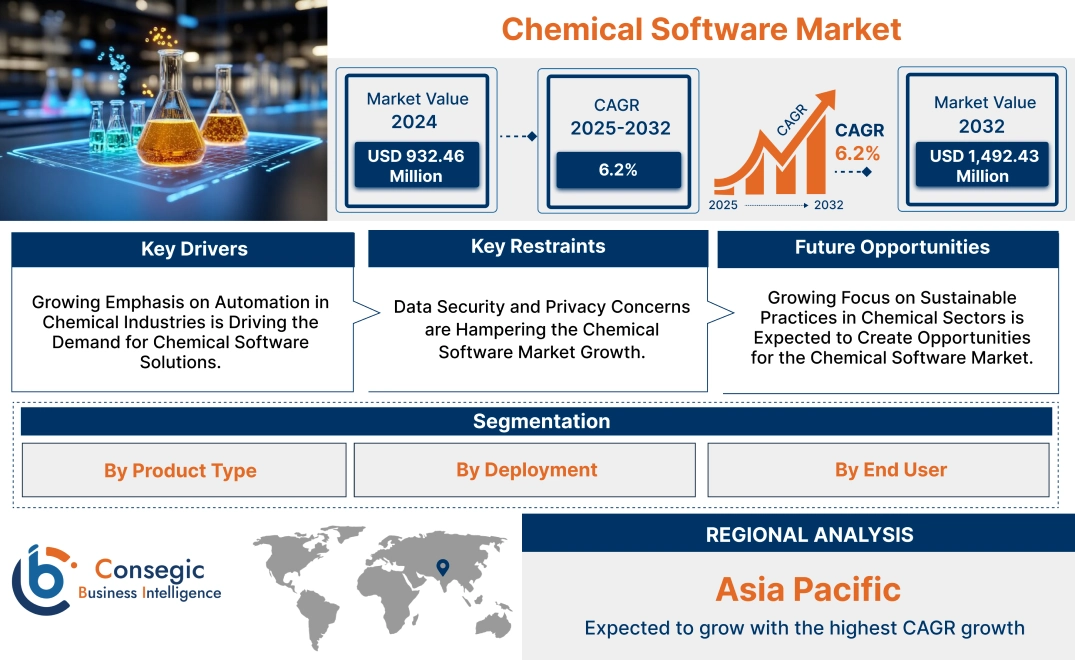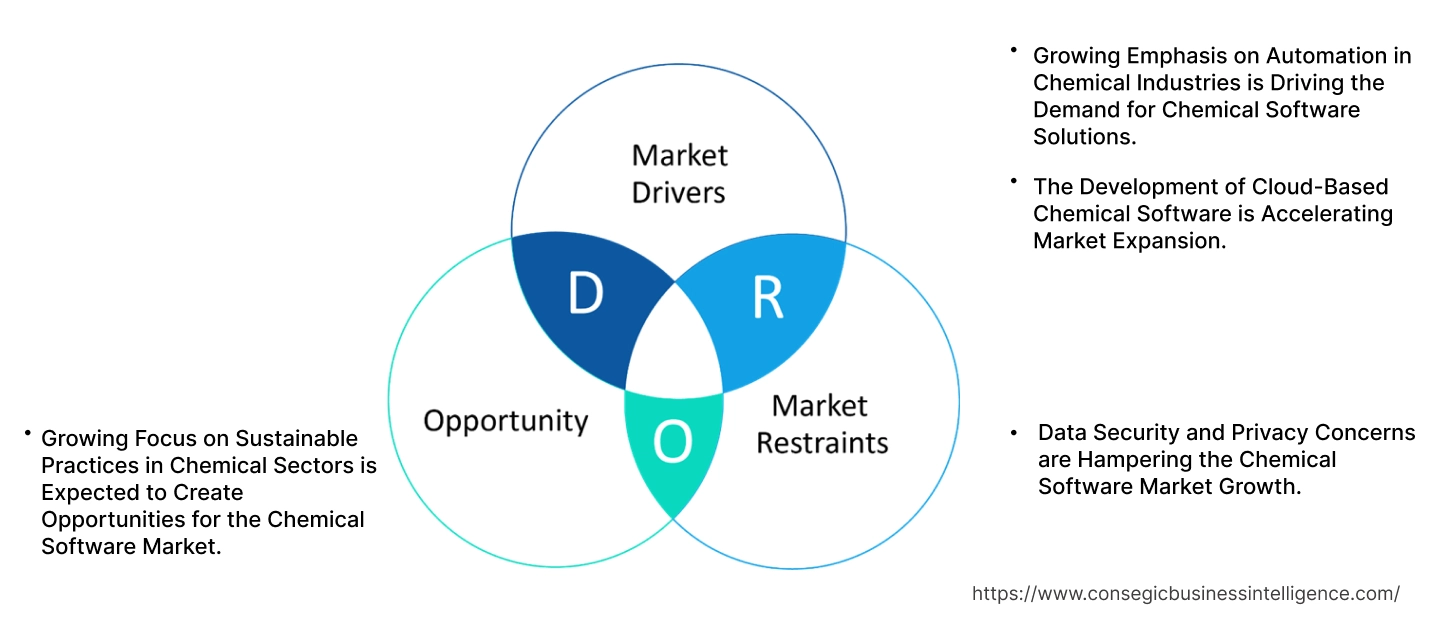Chemical Software Market Size:
Chemical Software Market size is growing with a CAGR of 6.2% during the forecast period (2025-2032), and the market is projected to be valued at USD 1,492.43 Million by 2032 from USD 932.46 Million in 2024.
Chemical Software Market Scope & Overview:
Chemical software is used to manage and optimize various aspects of the research & development and manufacturing process of chemicals. It aids in design, simulation, and analysis in the chemistry field. Several types of software include computational chemistry software, chemical management software, process simulation software, and others. This software help with tasks such as production planning, formula management, quality control, regulatory compliance, supply chain management, inventory management, tracking, safety compliance, and reporting among others. Owing to the wide range of applications, these software solutions serve as critical components for chemical manufacturers, pharmaceutical companies, research and development organizations, and others. Growing emphasis on automation in chemical sectors, development of cloud-based software solutions, and increasing focus on sustainable practices in chemical sectors are the prominent factors supporting the chemical software market expansion.
How is AI Transforming the Chemical Software Market?
The integration of AI is significantly transforming the chemical software market. The incorporation of AI in chemical software enables optimized chemical processes, faster discovery, improved product quality, and enhanced safety measures through advanced simulations and predictive modeling.
Moreover, AI-powered chemical software can analyze vast datasets to predict chemical behavior, accelerate discovery, and optimize formulations. This leads to faster innovation, reduced costs, and improved efficiency in chemical manufacturing. Consequently, the aforementioned factors are expected to drive the market growth in upcoming years.
Chemical Software Market Dynamics - (DRO) :
Key Drivers:
Growing Emphasis on Automation in Chemical Industries is Driving the Demand for Chemical Software Solutions.
The growing emphasis on automation in the chemical sector significantly drives the adoption of chemical software solutions. Automation technologies employed in chemical production necessitate sophisticated software for process control, optimization, and real-time adjustments. Leveraging chemical software such as process simulation software, process design software, and chemical management software among others allows companies to effectively monitor safety systems, streamline operations, ensure compliance with safety regulations, and reduce labor costs.
Moreover, this software plays a crucial role in integrating various automation systems, including robotics, machine vision, and artificial intelligence, into a cohesive and efficient production environment. Hence, there is a growing preference for the development of software solutions that promote automation in the chemical sector.
- For instance, in 2024, Clariant announced the launch of its CHEMVISION platform, an innovative tool designed to give real-time, data-driven insights for offshore chemical management. CHEMVISION is an integrated, cloud-based platform developed by Clariant to consolidate data from multiple sources, including daily field reports, lab analyses, production data, and IoT devices. By centralizing and automating data, CHEMVISION enables offshore teams to track chemical performance metrics in real time through interactive dashboards, enhancing operational transparency and response times.
Overall, by enabling the effective management, control, and optimization of automated systems, these software plays a crucial role in driving the automation initiatives within the chemical sectors.
The Development of Cloud-Based Chemical Software is Accelerating Market Expansion.
The emergence and rapid advancement of cloud-based software solutions represent a transformative shift in the chemical software industry. Cloud-based software refers to applications and programs stored and managed remotely accessible via the internet rather than locally installed software. This approach enables users to access and store data and programs online, eliminating the need for physical servers or local hard drive storage. This boosts the market growth significantly through enhanced accessibility, scalability, and cost-effectiveness. Additionally, cloud-based software eliminates the need for extensive on-premises infrastructure and costly hardware investments, making advanced technology solutions more accessible to companies of all scales.
- For instance, in June 2022, Quantistry, a Berlin-based software company, announced the launch of a cloud-based solution called Quantistry Lab for chemical simulations. Quantistry Lab makes it possible to determine material and molecular properties on a computer-based basis and thus decisively optimize development processes.
Overall, the development of cloud-based software solutions is accelerating chemical software market expansion.
Key Restraints:
Data Security and Privacy Concerns are Hampering the Chemical Software Market Growth.
Chemical companies handle highly sensitive information, encompassing intellectual property, confidential business data, and potentially hazardous material information. Cyberattacks pose a substantial threat, with the potential for data breaches leading to severe financial losses, reputational damage, and legal liabilities. Furthermore, operational disruptions resulting from cyberattacks pose a threat of production shutdowns, equipment failures, and safety hazards.
Additionally, stringent data privacy regulations, such as the General Data Protection Regulation (GDPR) and the California Consumer Privacy Act (CCPA), necessitate robust data security measures and the proper handling of personal and sensitive data. Non-compliance with these regulations results in substantial fines and legal repercussions. Overall, data security and privacy concerns constitute a significant constraint to chemical software market growth.
Future Opportunities :
Growing Focus on Sustainable Practices in Chemical Sectors is Expected to Create Opportunities for the Chemical Software Market.
The chemical sector is increasingly prioritizing sustainability. Companies are under increasing pressure to minimize their environmental impact, reduce waste, and develop more sustainable products. Chemical software plays a crucial role in this by enabling the design of greener processes, the development of sustainable products, and the conduct of life cycle assessments. Stringent environmental regulations are propelling the need for software solutions that help companies comply with emissions standards and waste disposal regulations. Moreover, investors and consumers are increasingly demanding that companies operate in a sustainable and environmentally responsible manner. Hence, software developers are focusing on the development of chemical software that promotes sustainability.
- For instance, in May 2024, AspenTech, a key player in industrial software solutions introduced a new solution called AspenTech Strategic Planning for Sustainability Pathways. This solution is designed to help companies make decisions related to carbon capture, utilization, and storage (CCUS) and develop sustainable strategies. The solution utilizes integrated modeling and optimization techniques to assess the feasibility and impact of different sustainability pathways. New software solution aims to assist companies in navigating the transition to a more sustainable future by providing them with the tools and insights needed to make informed decisions about their sustainability strategies.
Overall, the growing focus on sustainability serves as a chemical software market opportunity as it necessitates the development and implementation of innovative solutions that minimize environmental impact, optimize resource utilization, and promote a more sustainable future for the chemical sectors.
Chemical Software Market Segmental Analysis :
By Product Type:
Based on product type, the market is categorized into computational chemistry software, chemical management software, process simulation software, and others.
Trends in the Product Type:
- Integration of artificial intelligence and machine learning algorithms for computational chemistry.
- Increasing focus on sustainability features, such as tools for assessing the environmental impact of chemical processes, optimizing energy consumption, and minimizing waste generation.
The process simulation software segment accounted for the largest market share of 39.77% in 2024.
- Process simulation software is a computer-based tool that allows engineers to virtually construct and analyze chemical processes and systems. This sophisticated tool enables the modeling, evaluation, and optimization of these processes before their physical implementation.
- By generating virtual representations of processes, this software facilitates a comprehensive understanding of intricate interactions between various parameters.
- This software is essential in various areas of chemical engineering, including process design, troubleshooting, and performance optimization.
- The requirement for chemical simulation software is driven by several key factors. These include significant gains in operational efficiency, such as improved yields, reduced waste, and lower production costs.
- Compliance with stringent environmental and safety regulations is another major driver, as simulations help minimize emissions and ensure safe operations.
- Moreover, advancements in technology, such as increased computing power and the integration of artificial intelligence, are enabling more sophisticated simulations and driving segments in the chemical software market trend.
The computational chemistry software segment is expected to grow at the fastest CAGR over the forecast period.
- Computational chemistry software encompasses tools designed to simulate and analyze molecular structures, reactions, and properties, including molecular modeling, quantum mechanics, and cheminformatics.
- These tools find critical applications in drug discovery, materials science, biotechnology, and environmental science.
- Factors driving the requirement for computational chemistry software include advancements in computing power that enable more complex and accurate simulations, the growing need for drug discovery within the pharmaceutical sector, the increasing demand for advanced materials across various sectors, and the growing emphasis on green chemistry and sustainable solutions.
- For instance, in September 2024, XtalPi, a quantum physics-based, AI-powered drug R&D company, announced the launch of announced the official launch of computational chemistry software XFEP and XMolGen, designed to accelerate and enhance the efficiency of drug discovery.
- Overall, computational chemistry software plays a crucial role in various scientific disciplines, driving innovation in drug discovery, materials science, and others propelling the segment.
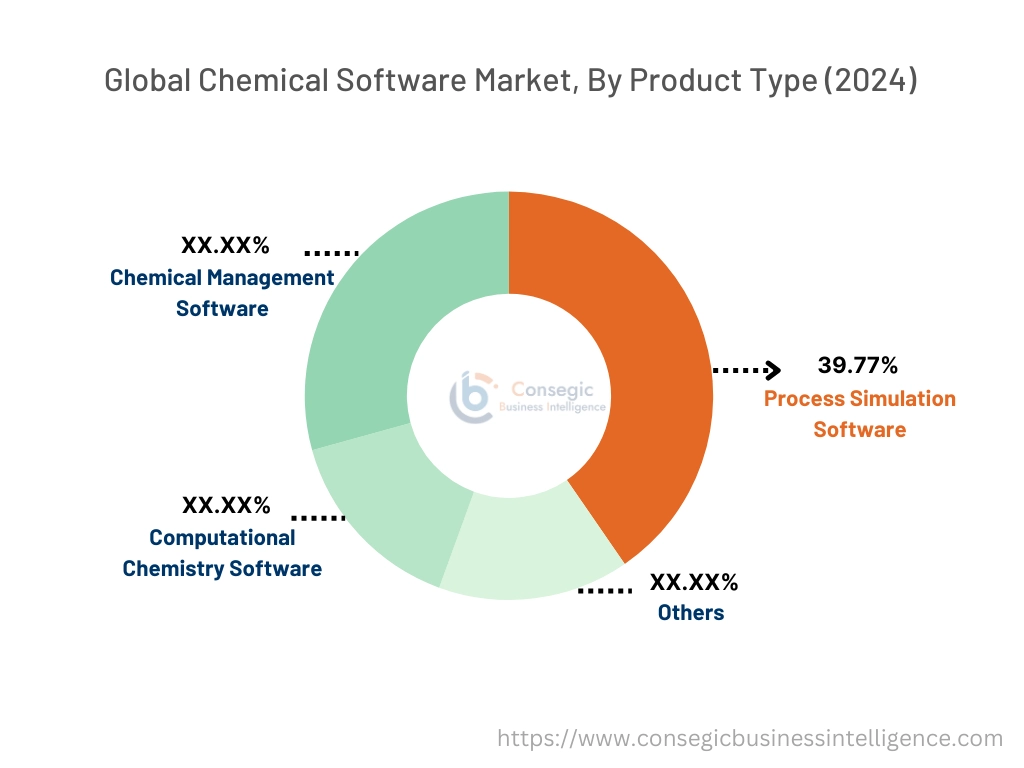
By Deployment:
Based on deployment, the market is bifurcated into on-premises and cloud-based.
Trends in Deployment:
- The adoption of subscription-based pricing models and software-as-a-service offerings is the trend influencing the deployment of software
The on-premises segment accounted for the largest market share in the year 2024.
- On-premises software is installed and run on local servers or computers. It is deployed in a server connected to a local network, allowing other devices on the same network to access it.
- In this model, dental clinics and hospitals purchase and install software on their data centers. Their internal IT teams handle the infrastructure needed to ensure secure and scalable software usage.
- On-premises software provides complete control over customization and data security, ensuring that the user’s specific needs are met.
- By optimizing performance for specific hardware and network infrastructure, on-premises software delivers faster response times and smoother user experience.
- Overall, based on dental software market analysis on-premises solutions continue to be a viable option due to their focus on data security, customization, performance, and long-term cost-effectiveness.
The cloud-based segment is expected to grow at the fastest CAGR over the forecast period.
- A cloud-based system is a broad term for anything that involves the delivery of hosted services via the Internet. Cloud-based software refers to a program or application that's stored, managed, and available through the cloud or internet. Computing with cloud-based software is utilized to access and store programs and data over the internet, rather than on a server at a physical location or on the hard drive of the computer.
- Cloud-based chemical software eliminates the need for expensive hardware and IT infrastructure, making it a cost-effective solution. Its scalability allows practices to adapt to changing needs. Moreover, automatic updates ensure that software presents the latest features and security patches. Hence, the several advantages provided by cloud-based deployment fuel the introduction of advanced cloud-based software.
- For instance, in March 2024, Clariant, a sustainability-focused specialty chemical company, announced the release of CLARITY Prime, a cutting-edge software solution for syngas plants, an upgrade of its cloud-based service portal CLARITY. CLARITY Prime is available for ammonia, methanol, and hydrogen producers and allows customers to forecast catalyst performance by combining actual data with predictive scenarios.
- Overall, cloud-based deployment offers numerous advantages, including cost-effectiveness, scalability, and automatic updates. This is evident in the recent release of CLARITY Prime by Clariant, demonstrating the trend of growing adoption of cloud-based solutions in the chemical sector.
By End User:
Based on end-user, the market is categorized into chemical manufacturers, pharmaceutical companies, research & development organizations, and others.
Trends in the End User:
- Implementing predictive maintenance models using software to anticipate equipment failures, minimize downtime, and optimize production schedules.
The chemical manufacturers segment accounted for the largest chemical software market share in the year 2024.
- Chemical manufacturers constitute the dominant end-user segment within the market. This significant reliance stems from the critical role software plays across various aspects of their operations including production planning, process optimization, quality control, and supply chain management.
- Chemical software optimizes processes, enhancing yield, minimizing waste, and improving energy efficiency. It ensures quality control through data analysis and predictive modeling.
- Furthermore, it streamlines supply chain management, improves safety and environmental compliance, and accelerates research and development through computational chemistry and process simulations.
- For instance, according to the data provided by GE Vernova, it is stated that SIPCHEM (Sahara International Petrochemical Company) leveraged GE Vernova's APM Integrity software to optimize inspection efficiency, resulting in a 31.5% reduction in inspection tasks.
- Overall, as per analysis, chemical manufacturers heavily rely on software across their operations. This enhances efficiency, improves quality, streamlines supply chains, ensures safety, and accelerates R&D.
The pharmaceutical companies segment is expected to grow at the fastest CAGR over the forecast period.
- Pharmaceutical companies represent a rapidly growing end-user segment within the chemical software market analysis. This significant rise is driven by the critical role of software in accelerating drug discovery and development processes.
- Computational chemistry software plays a pivotal role in drug discovery, enabling researchers to design and screen potential drug candidates, predict their properties and behavior, model protein-ligand interactions, identify potential drug targets, and optimize lead compounds for improved efficacy and reduced side effects.
- The need to bring new drugs to market faster and the high cost of drug development necessitate efficient and cost-effective research methods, driving the adoption of software solutions.
- Additionally, advancements in technology, such as AI/ML integration and high-performance computing, enable more sophisticated simulations and analyses, accelerating drug discovery.
- Moreover, the stringent regulatory requirements necessitate robust data management systems. These factors contribute to the growing requirement for chemical software within the pharmaceutical sector, driving innovation and improving the efficiency and success rate of drug discovery and development efforts.
Regional Analysis:
The regional segment includes North America, Europe, Asia Pacific, the Middle East and Africa, and Latin America.
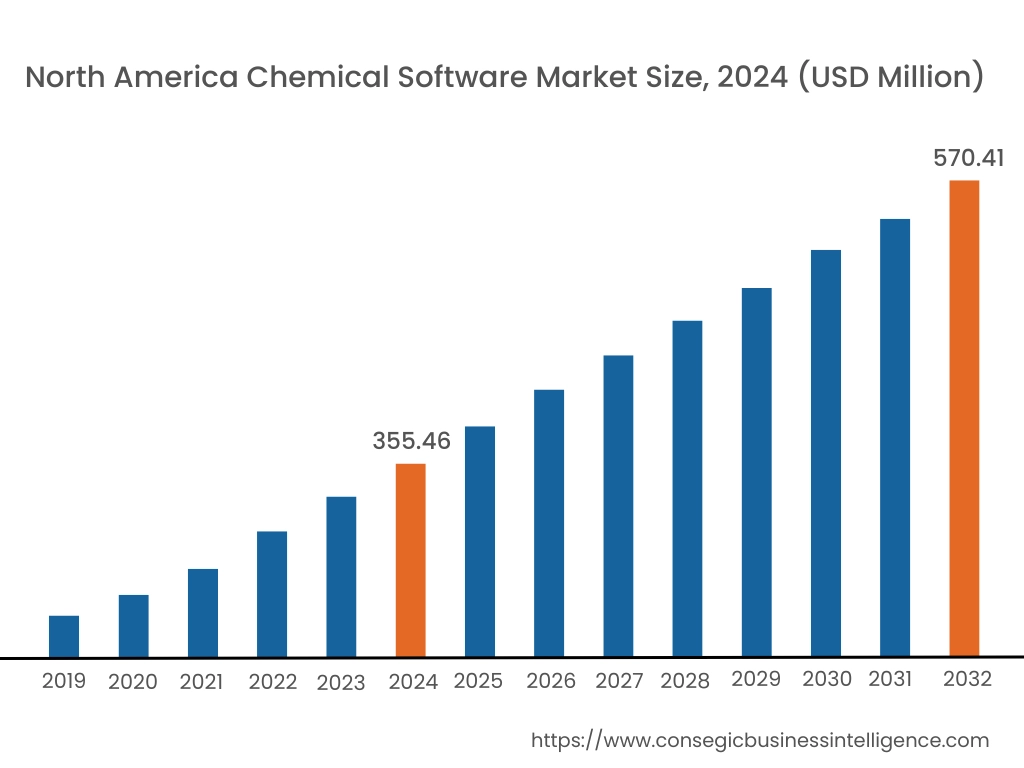
In 2024, North America accounted for the highest market share at 38.12% and was valued at USD 355.46 Million and is expected to reach USD 570.41 Million in 2032. In North America, the U.S. accounted for the highest market share of 78.21% during the base year of 2024.
North America dominates the global chemical software market. The region boasts a robust presence of leading chemical and pharmaceutical companies, driving a high requirement for sophisticated software solutions to optimize operations, enhance research and development, and ensure regulatory compliance. Moreover, North America possesses a well-developed technological infrastructure with strong expertise in areas like software development, data analytics, and cloud computing, fostering innovation and supporting the development and adoption of advanced chemical software solutions.
- For instance, in December 2023, MilliporeSigma, the U.S. and Canada Life Science business of Merck KGaA, launched its AIDDISON drug discovery software, the first software-as-a-service platform that bridges the gap between virtual molecule design and real-world manufacturability through Synthia retrosynthesis software application programming interface (API) integration. The platform enables any laboratory to leverage generative AI to identify the most suitable drug candidates within a vast chemical space. This approach ensures the optimal chemical synthesis route for target molecule development.
Furthermore, North American companies tend to be early adopters of new technologies, such as artificial intelligence, cloud computing, and IoT, which are increasingly integrated into chemical software solutions. The region also has stringent regulatory requirements for environmental protection, safety, and product quality, necessitating the use of software for compliance and risk management. The combination of the aforementioned factors and trends is driving a substantial trajectory in North America.
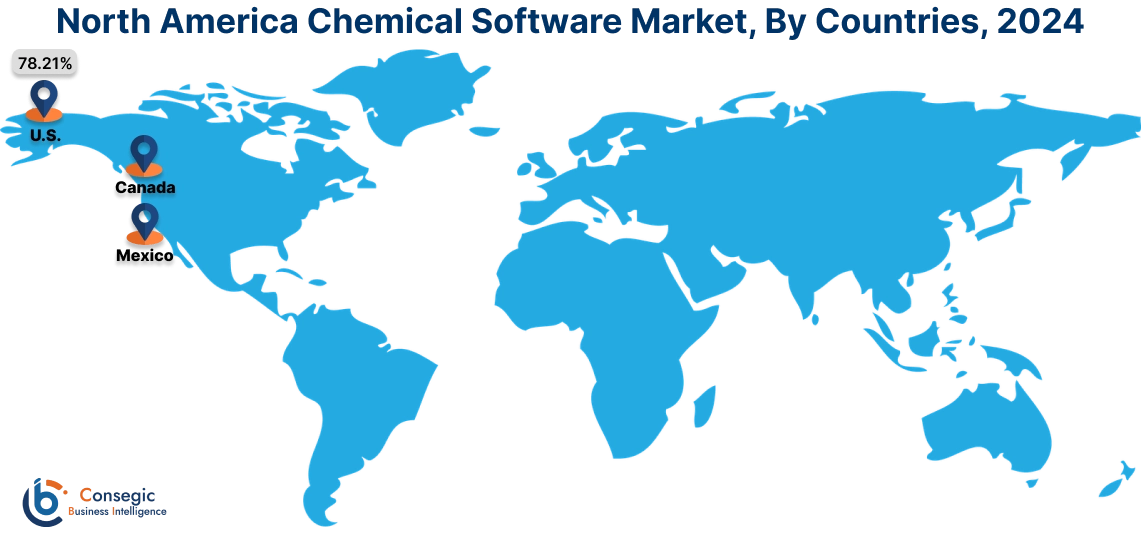
Asia Pacific is experiencing the fastest growth with a CAGR of 6.8% over the forecast period. The chemical software market trend across the region is attributed to factors such as the significant growth in the chemical manufacturing sectors, leading to a strong requirement for software solutions to optimize production processes and enhance competitiveness. Substantial investments are being made in chemical production facilities, necessitating the adoption of advanced software solutions to manage complex operations and ensure quality control. Furthermore, many governments in the region are actively promoting technological advancements and encouraging the adoption of advanced technologies in various sectors, including the chemical sector. This includes initiatives to support research and development, foster innovation, and improve industrial competitiveness creating significant chemical software market opportunities.
Europe presents a significant contribution to the chemical software market analysis characterized by the strong presence of established chemical and pharmaceutical sectors, driving the requirement for sophisticated solutions including chemical software. This region emphasizes sustainability, with stringent environmental regulations driving the requirement for software that minimizes environmental impact. Europe boasts the presence of numerous world-class research institutions, fostering a strong culture of innovation and driving demand for advanced research tools. Moreover, there is a growing emphasis on the circular economy across European countries, driving the adoption of software solutions that support waste reduction and resource recovery. Collectively these factors create a favorable environment for chemical software market demand across Europe.
Latin America is an emerging region in the chemical software market share, with significant innovation potential. Latin America boasts a growing chemical sector with increasing requirements for efficient and cost-effective production processes. The region is experiencing economic growth, leading to increased industrial activity and a rising demand for chemicals in various sectors. The ongoing industrialization process across Latin America is driving the adoption of software solutions to optimize production processes, improve efficiency, and enhance competitiveness. Many Latin American countries are focusing on expanding their exports of chemical products, necessitating the adoption of advanced technologies and efficient production processes. Furthermore, government initiatives aimed at promoting industrial growth and technological development are creating a favorable environment for the adoption of software solutions.
The Middle East and Africa (MEA) region is witnessing notable chemical software market demand characterized by significant potential. The region is rich in oil and gas resources, driving the development of related sectors such as petrochemicals, refining, and downstream processing, necessitating the use of advanced software solutions for process optimization, safety, and environmental compliance. Many countries are actively pursuing economic diversification strategies, with a focus on developing new sectors such as pharmaceuticals and renewable energy, driving the adoption of chemical software solutions to support these emerging sectors. Government initiatives to promote industrial growth, technological advancement, and economic diversification will create a favorable environment for the adoption of software solutions.
Top Key Players and Market Share Insights:
The chemical software market is highly competitive with major players providing products to the national and international markets. Key players are adopting several strategies in research and development (R&D) and product innovation to hold a strong position in the global chemical software market. Key players in the Chemical Software industry include-
- Chemstations (U.S.)
- SAP (U.S.)
- BatchMaster (U.S.)
- Fives ProSim (France)
- AspenTech (U.S.)
- General Electric Company (U.S.)
- AVEVA Group (UK)
- Sphera (U.S.)
- SoftFormance (Estonia)
- Oracle (U.S.)
Recent Industry Developments :
Product Launch:
- In March 2024, Clariant, a sustainability-focused specialty chemical company, announced the release of CLARITY Prime, a cutting-edge software solution for syngas plants. CLARITY Prime is available for ammonia, methanol, and hydrogen producers and allows customers to forecast catalyst performance by combining actual data with predictive scenarios.
- In June 2022, Quantistry, a Berlin-based software company, announced the launch of a cloud-based solution called Quantistry Lab for chemical simulations. Quantistry Lab makes it possible to determine material and molecular properties on a computer-based basis and thus decisively optimize development processes.
Chemical Software Market Report Insights :
| Report Attributes | Report Details |
| Study Timeline | 2019-2032 |
| Market Size in 2032 | USD 1,492.43 Million |
| CAGR (2025-2032) | 6.2% |
| By Product Type |
|
| By Deployment |
|
| By End User |
|
| By Region |
|
| Key Players |
|
| North America | U.S. Canada Mexico |
| Europe | U.K. Germany France Spain Italy Russia Benelux Rest of Europe |
| APAC | China South Korea Japan India Australia ASEAN Rest of Asia-Pacific |
| Middle East and Africa | GCC Turkey South Africa Rest of MEA |
| LATAM | Brazil Argentina Chile Rest of LATAM |
| Report Coverage |
|
Key Questions Answered in the Report
How big is the Chemical Software market? +
In 2024, the Chemical Software market is USD 932.46 Million.
Which is the fastest-growing region in the Chemical Software market? +
Asia Pacific is the fastest-growing region in the Chemical Software market.
What specific segmentation details are covered in the Chemical Software market? +
Product Type, Deployment, and End User segmentation details are covered in the Chemical Software market.
Who are the major players in the Chemical Software market? +
Chemstations (U.S.), SAP (U.S.), and BatchMaster (U.S.) are some of the major players in the market.
